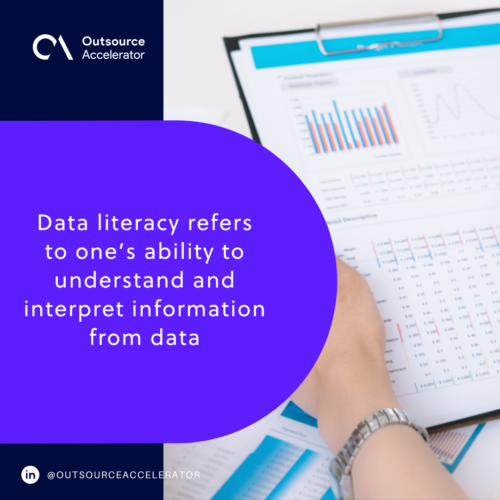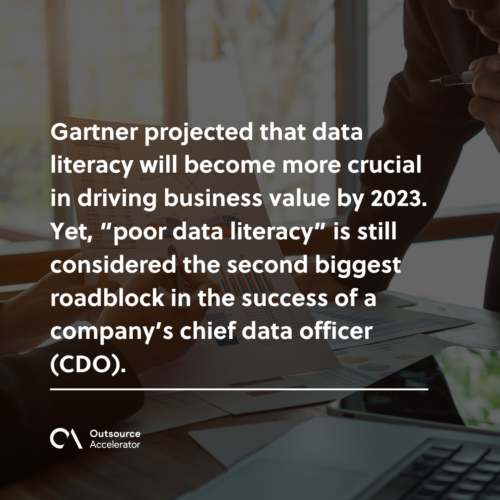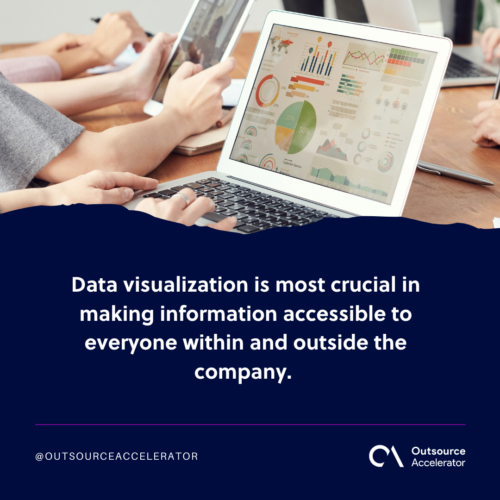A beginner’s guide to data literacy and the skills your employees need

Data has become a crucial tool for success in global enterprises in the past decades. It helps companies make more accurate decisions and evaluate their strategies better.
Gathering data is easy. However, interpreting and transforming it into useful information requires a level of data literacy on the company’s part. The majority of companies nowadays still don’t consider themselves “fully data-driven,” with only 24% of organizations claiming to be one.
There’s an increasing need for companies to be data-literate, with the tight competition in the market. Get to know more about data literacy and how companies can improve it in this article.
What is data literacy?
Data literacy refers to one’s ability to understand and interpret information from data. In general, the concept goes similar to literacy, where an individual should know how to read, write, and apply information in different ways.
An individual is not required to be an expert to acquire data literacy. Rather, they only have to know the basics, such as the following.
- Types of data
- Data sources
- Types of data analysis
- Tools and techniques for data interpretation

Why data literacy is crucial for a company
Gartner projected that data literacy will become more crucial in driving business value by 2023. Yet, “poor data literacy” is still considered the second biggest roadblock in the success of a company’s chief data officer (CDO).
Adequate data literacy is the key to achieving digital transformation in a company. It can help businesses sharpen their competitive edge, especially with the fast-paced and aggressive global economy today.
At the same time, it can help them achieve the following.
Better data-driven decisions
Data-literate teams can help businesses improve in terms of their processes and strategies. At the same time, it helps them create more informed decisions instead of acting on pure instinct and gut feel.
It makes the digital transformation easier with companies being “all hands on deck” with the move. This is since, according to McKinsey, employees are more likely to agree to change when they know about it.
Mitigated risks in artificial intelligence (AI)
Companies using artificial intelligence (AI) are exposed to risks and security threats that could affect their data. This includes breaches, AI biases, and several errors in handling.
Data literacy protects companies from these risks. Their CDO and teams can easily evaluate the potential risks in their system and figure out how to troubleshoot and prevent them in advance. As a result, businesses can ensure the safety and fairness of their AI systems.
Added employee productivity and competency
Data-literate employees are more productive and competitive at work. A recent survey by Qlik shows that 85% of workers say they can perform well in the workplace, as compared to the majority of the workforce.
At the same time, more employees worldwide are willing to invest in improving their data skillsets with the increasing demand for data-driven companies globally.

Data literacy skills your employees should learn
To become data-literate, companies should train and empower their employees to possess the following skills needed in handling data.
Data analysis
Data analysis, also known as data analytics, is the process of analyzing raw data to make informed decisions. It involves several processes like gathering, inspecting, cleaning, and transforming data for business purposes.
Several types of data analysis can be applied depending on the purpose and technology used by the business, including the following.
- Statistical analysis. Applies most to quantitative research. It aims to analyze trends and findings on a larger population by getting information on a sample portion.
- Descriptive analysis. Deals with “what happened” in the past. It simply describes the information in detail without other explanation on its cause or solution.
- Diagnostic analysis. Involves finding the root cause of an interpretation. It aims to find anomalies and respond to them timely.
- Prescriptive analysis. Looks at the future outcomes of data and the things that should be done to prevent or achieve them. It takes into consideration all the possible pathways a business could take and their possible results.
Data wrangling
Also known as data cleaning, data wrangling refers to the process of transforming raw data into something that can be readily used.
Data wrangling can be done in different forms and ways, including removing errors and merging data sources. Companies handling large volumes are usually required to clean their data regularly, usually with the help of automation.
Data visualization
Meanwhile, data visualization shows gathered information in visual form, whether through text or images. This provides a better understanding and interpretation of information through charts, graphs, and maps to better track trends and patterns.
Data visualization is most crucial in making information accessible to everyone within and outside the company.
Data ecosystem
A data ecosystem refers to multiple sets of infrastructures, applications, and other aspects used to collect, transform, and store data.
While each organization has different ways of interpreting data, companies can use similar applications such as online tools and cloud storage to process information. An example of a data ecosystem is the “tech stack” or a set of applications used in building websites and mobile apps.
Data governance
Lastly, data governance refers to the entire system of handling, managing, and securing data based on the standards and policies of the enterprise. It is usually written in the form of a “data policy” implemented by the business.
Data governance ensures that the company’s data is secure, complete, and trustworthy.

Building data literacy in your business
Data literacy is now considered a second language for businesses worldwide. Yet, most leaders still don’t utilize and value their data enough and understand what it can do to their growth.
While most of them are confident that their teams already know how to handle data, only a few are still considered data-literate. This creates data literacy gaps that could affect the entire operations forward.
Developing data literacy skills is a smart move for companies, especially in a data-driven economy. Organizations can build and improve data literacy within their operations by doing the following measures.
Assess data literacy within teams
Leaders can assess data literacy across their company by asking a few questions:
- How many people are aware and can interpret data in your team?
- Can your managers and employees explain the output of their systems?
- How many of your teams can construct decisions based on relevant figures?
- Do your clients appreciate and understand the data you share with them?
Establish training programs regarding data literacy
More than the academic institutions, employers are now responsible for training their workers about data literacy.
Data officers should establish data literacy training programs for employees. This is the best way to cultivate the culture of learning within the organization, helping them learn better by rewarding their curiosity.
You can also partner with an outsourcing firm to help you effectively train your staff about data literacy.
Eclaro, a BPO company located in the Philippines has a data analytics professionals who assist clients in acquiring insights from their data by guiding them through a thorough process. Their assistance includes data profiling, governance, security, and management.
Choose a tool or system that’s easy to use
Data-driven employees work better with easy-to-use data processing software in the market. Learning curves are normal when working with complex data and trends. This is why having a user-friendly tool can help them learn easier.
Include data in your company culture
Businesses should make sure that their teams have the knowledge and responsibilities to utilize data.
Technology is not the sole driver for digital literacy. Rather, companies should incorporate adequate training and guidance for teams regardless of their level of knowledge in managing data.







 Independent
Independent




